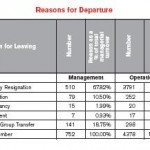ColmarCo Labour T/O
- Will they be able to find someone as good?
- How much will it cost them to do so? […. The irony is that they will probably have to substantially increase the salary attached to the post to attract such a person (who will still be unproven and may not be nearly as effective!) … an increase that they didn’t seem to want to offer him perhaps thinking that in this current employment market he would never leave. Bad move!]
OK, so that is a real but anecdotal case study, but now let’s consider things from the employer’s point of view……..
Colmarco Internal Memo
From: Chief Executive’s Office
To: Task Teams working on reducing Labour Turnover (i.e. YOU!)
Re: The Size of Our Labour Turnover Problem: ‘read it and weep’
I thought it would help were I to let you have the key internal statistics on this matter: they do NOT make very happy reading at all and demonstrate the scale of the staff retention problem facing us: we are haemorrhaging employees at an unsustainable rate at all levels from ground floor to the top – the loss at managerial level being particularly disastrous to my mind after we have invested so heavily in them in terms of training and professional development.
One might think we’d be grateful for this in the current financial crisis, but this is not the case: we are now beginning to suffer a distinct loss of managerial and operational capability – and I fear for our reputation too.
This is doubtless costing us a fortune (a pit into which we are effectively directly ‘throwing’ our hard-won operational profits) and I want comprehensive, workable solutions, as they say: ‘yesterday’. We need to cut these costs and to re-design and develop a recruitment, selection and retention system which is imbued with the three Grace’s of:
- Efficiency
- Economy
- Effectiveness
The figures:
Overall Group Labour Turnover is 48.64% This in return reflects:
- Turnover at Managerial level : 39.19%
- Turnover at Operational level : 50.74%
Reasons for Leaving are as follows:-
NB. If not all the above image shows: click on it. Then to get back to this page using the ‘back’ button.
Timing of Leaving.
- 55% of the Managerial Level leavers resign in their first 6 months
- 70% of Operational Level leavers resign in their first 6 months
What I need to know is the following:
– What are the Direct, quantifiable costs* of replacing lost staff?
- At Management level ?????? Euros per person
- At Operational level ?????? Euros per person
– What are the not-yet-quantifiable but nonetheless REAL costs such as impaired performance, lowering morale etc… [When someone leaves and is replaced one does not necesarily see these costs in the financial accounts, but with time – comparing year-on-year – they become real, calculateable, financial costs which are attributable to labour turnover]. One thing we do NOT want to be doing is to be working hard to generate profit at the operational level only to see this disappear into a labour turnover costs ‘black hole’ of our own making.
SO: ‘Do the Math‘ for me (and yourselves!) : how much is this costing the company per year in quantifyable and non-quantfyable terms???)
Imagine quantifyable costs (including ‘côtisations’) as follows:
One hour of a manager’s time = 100 Euros
One hour of an administrator’s (or secretary’s) time = 50 Euros
Think about this in THREE broad phases:
- Phase One: costs (quantifiable and non-quantifiable) flowing from the employee’s decision to leave (a decision which he/she may take a good time before actually resigning and leaving) right through until the new recruit has arrived (BUT do NOT include recruitment and selection costs – that is for the next phase).
- Phase Two: Recruitment costs from the day the employee resigns (‘hands in his notice‘) until the creation of a shortlist of the 10 best candidates for interview. (Assume 250 applicants)
- Phase Three: Selection and appointment costs. (Assume a panel of three managerial interviewers over two full days for a managelment post and just one for the other posts). This runs from organising interviews, tests etc, inviting the candidates, interviewing, deliberating…. through to a signed contract and any pre-arrival costs.
- Group Brainstorm based on above: How to redesign an efficient, effective and economical system for recruitment, selection AND retention.
- This must be accompanied by a cost comparison with our present system: I want to get a sense of the degree of cost-saving involved in the strategy you are proposing.
Go to it! We need the solution in place asap! The company’s future – and needless to say your jobs – are on the line!
CEO ColmarCo TJ Signature illisible
OK. Out of role for a minute: you should learn a lot from this exercise in relation to ‘good’ recruitment, slection and retention practices which will help you understand WHY employers’ HRM departments are doing what they do.
Understanding this will make you a stronger applicant both on paper AND at interview!




